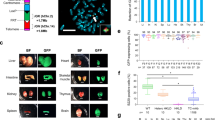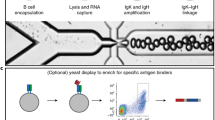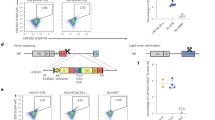Abstract
Antigen-specific human polyclonal antibodies (hpAbs), produced by hyperimmunization, could be useful for treating many human diseases. However, yields from available transgenic mice and transchromosomic (Tc) cattle carrying human immunoglobulin loci are too low for therapeutic applications. We report a Tc bovine system that produces large yields of hpAbs. Tc cattle were generated by transferring a human artificial chromosome vector carrying the entire unrearranged, human immunoglobulin heavy (hIGH) and κ-light (hIGK) chain loci to bovine fibroblasts in which two endogenous bovine IgH chain loci were inactivated. Plasma from the oldest animal contained >2 g/l of hIgG, paired with either human κ-light chain (up to ∼650 μg/ml, fully human) or with bovine κ- or λ-light chain (chimeric), with a normal hIgG subclass distribution. Hyperimmunization with anthrax protective antigen triggered a hIgG-mediated humoral immune response comprising a high proportion of antigen-specific hIgG. Purified, fully human and chimeric hIgGs were highly active in an in vitro toxin neutralization assay and protective in an in vivo mouse challenge assay.
This is a preview of subscription content, access via your institution
Access options
Subscribe to this journal
Receive 12 print issues and online access
$259.00 per year
only $21.58 per issue
Buy this article
- Purchase on SpringerLink
- Instant access to full article PDF
Prices may be subject to local taxes which are calculated during checkout




Similar content being viewed by others
References
Lemieux, R., Bazin, R. & Neron, S. Therapeutic intravenous immunoglobulins. Mol. Immunol. 42, 839–848 (2005).
Jolles, S., Sewell, W.A.C. & Misbah, S.A. Clinical uses of intravenous immunoglobulin. Clin. Exp. Immunol. 142, 1–11 (2005).
Newcombe, C. & Newcombe, A.R. Antibody production: polyclonal-derived biotherapeutics. J. Chromatogr. B Analyt. Technol. Biomed. Life Sci. 848, 2–7 (2007).
Lonberg, N. Human antibodies from transgenic animals. Nat. Biotechnol. 23, 1117–1125 (2005).
Waltz, E. Polyclonal antibodies step out of the shadows. Nat. Biotechnol. 24, 1181 (2006).
Kuroiwa, Y. et al. Cloned transchromosomic calves producing human immunoglobulin. Nat. Biotechnol. 20, 889–894 (2002).
Kitamura, D., Roes, J., Kuhn, R. & Rajewsky, K.A. B cell-deficient mouse by targeted disruption of the membrane exon of the immunoglobulin μ chain gene. Nature 350, 423–426 (1991).
Tomizuka, K. et al. Double trans-chromosomic mice: Maintenance of two individual human chromosome fragments containing Ig heavy and κ loci and expression of fully human antibodies. Proc. Natl. Acad. Sci. USA 97, 722–727 (2000).
Yel, L. et al. Mutations in the mu heavy chain gene in patients with agammaglobulinemia. N. Engl. J. Med. 335, 1486–1493 (1996).
Hayes, H.C. & Petit, J.E. Mapping of the β-lactoglobulin gene and of immunoglobulin M heavy chain-like sequence to homologous cattle, sheep and goat chromosomes. Mamm. Genome 4, 207–210 (1993).
Hosseini, A., Campbell, G., Prorocic, M. & Aitken, R. Duplicated copies of the bovine JH locus contribute to the Ig repertoire. Int. Immunol. 16, 843–852 (2004).
Chowdhary, B.P., Fronicke, L., Gustavsson, I. & Scherthan, H. Comparative analysis of the cattle and human genomes: detection of ZOO-FISH and gene mapping-based chromosomal homologies. Mamm. Genome 7, 297–302 (1996).
Tobin-Janzen, T.C. & Womack, J.E. Comparative mapping of IGHG1, IGHM, FES and FOS in domestic cattle. Immunogenetics 36, 157–165 (1992).
Gu, F., Chowdhary, B.P., Andersson, L., Harbitz, I. & Gustavsson, I. Assignment of the bovine immunoglobulin gamma heavy chain (IGHG) gene to chromosome 21q24 by in situ hybridization. Hereditas 117, 237–240 (1992).
Zhao, Y., Kacskovics, I., Rabbani, H. & Hammarstrom, L. Physical mapping of the bovine immunoglobulin heavy chain constant region gene locus. J. Biol. Chem. 278, 35024–35032 (2003).
Reynaud, C.A., Mackay, C.R., Muller, R.G. & Weill, J.-C. Somaticgeneration of diversity in a mammalian primary lymphoid organ: the sheep ileal Peyer's patches. Cell 64, 995–1005 (1991).
Jenne, C.N., Kennedy, L.J., McCullagh, P. & Reynolds, J.D. A new model of sheep Ig diversification: shifting the emphasis toward combinatorial mechanisms and away from hypermutation. J. Immunol. 170, 3739–3750 (2003).
Butler, J.E. Immunoglobulin diversity, B-cell and antibody repertoire development in large farm animals. Rev. Sci. Tech. 17, 43–70 (1998).
Butler, J.E. Immunological diversity, B-cell and antibody repertoire development in large farm animals. Rev. Sci. Tech. 17, 43–70 (1998).
Meyer, A. et al. Immunoglobulin gene diversification in cattle. Int. Rev. Immunol. 15, 165–183 (1997).
Aitken, R. et al. Structure and diversification of the bovine immunoglobulin repertoire. Vet. Immunol. Immunopathol. 72, 21–29 (1999).
Lucier, M.R. et al. Multiple sites of Vλ diversification in cattle. J. Immunol. 161, 5438–5444 (1998).
Kuroiwa, Y. et al. Sequential targeting of the genes encoding immunoglobulin-μ and prion protein in cattle. Nat. Genet. 36, 775–780 (2004).
Alt, F.W., Blackwell, T.K. & Yancopoulos, G.D. Development of the primary antibody repertoire. Science 238, 1079–1087 (1987).
Hood, L., Gray, W.R., Sanders, B.G. & Dreyer, W.Y. Light chain evolution: antibodies. Cold Spring Harbor Symp. Quan. Bio. 32, 133–146 (1967).
Kuroiwa, Y. et al. Manipulation of human minichromosomes to carry greater than megabase-sized chromosome inserts. Nat. Biotechnol. 18, 1086–1090 (2000).
Brey, R.N. Molecular basis for improved anthrax vaccines. Adv. Drug Deliv. Rev. 57, 1266–1292 (2005).
Raju, T.S., Briggs, B.J., Borge, M.S. & Jones, J.S.A. Species-specific variation in glycosylation of IgG: evidence for species-specific sialylation and branch-specific galactosylation and importance for engineering recombinant glycoprotein therapeutics. Glycobiology 10, 477–486 (2000).
Hering, D., Thompson, W., Hewetson, J., Little, S., Norris, S. & Pace-Templeton, J. Validation of the anthrax lethal toxin neutralization assay. Biologicals 32, 17–27 (2004).
Pittman, P.R., Parker, & Friedlander, A.M. Anthrax vaccine: immunogenicity and safety of a dose-reduction, route-change comparison study in humans. Vaccine 20, 1412–1420 (2002).
Semenova, V.A. et al. Mass value assignment of total and subclass immunoglobulin G in a human standard anthrax reference serum. Clin. Diagn. Lab. Immunol. 11, 919–923 (2004).
Wakayama, T. et al. Cloning of mice to six generations. Nature 407, 318–319 (2000).
Kubota, C., Tian, X.C. & Yang, X. Serial bull cloning by somatic cell nuclear transfer. Nat. Biotechnol. 22, 693–694 (2004).
Mann, M.R. et al. Disruption of imprinted gene methylation and expression in cloned preimplantation stage mouse embryos. Biol. Reprod. 69, 902–914 (2003).
Rideout, W.M., Eggan, K. & Jaenisch, R. Nuclear cloning and epigenetic reprogramming of the genome. Science 293, 1093–1098 (2001).
Tamashiro, K.L. et al. Cloned mice have an obese phenotype not transmitted to their offspring. Nat. Med. 8, 262–267 (2002).
Knight, K.L., Kingzette, M., Crane, M.A. & Zhai, S.K. Transchromosomally derived Ig heavy chains. J. Immunol. 155, 684–691 (1995).
Nolan-Willard, M., Berton, M.T. & Tucker, P. Coexpression of mu and gamma 1 heavy chains can occur by a discontinuous transcription mechanism from the same unrearranged chromosome. Proc. Natl. Acad. Sci. USA 89, 1234–1238 (1992).
Kamoda, S., Ishikawa, R. & Kakehi, K. Capillary electrophoresis with laser-induced fluorescence detection for detailed studies on N-linked oligosaccharide profile of therapeutic recombinant monoclonal antibodies. J. Chromatogr. A. 1133, 332–339 (2006).
Acknowledgements
We thank the teams at Transova Genetics for their efforts in embryo transfer and at the Research Development Center for their assistance in fetal and sample collection, calf delivery and care. We thank the teams at Hematech Inc. for their assistance in gene targeting, cell culture, embryonic cloning and any other technical procedures. We also thank Ralph Kubo, Sandra Rickert, Mareto Hosono and Tomoyuki Tahara for their useful comments on the immunological study.
Author information
Authors and Affiliations
Contributions
Y.K. and J.M.R. led the work and wrote the manuscript. P.K. and J.K. led animal cloning. T.S. and H.W. led immunological analyses and immunization. J.J. led purification and protein chemistry. H.M. and J.S. carried out gene targeting experiments. J.M. conducted the mouse challenge assay. M.H. performed flow cytometry analysis. S.K. and K.T. implemented sugar chain analyses. I.I. initiated the work.
Corresponding authors
Ethics declarations
Competing interests
Work described in this paper was funded in part by Kyowa Hakko Kirin Co., Ltd. (Kyowa Kirin) and in part by a Small Business Innovation Research Phase II grant (no. 5R44A1054086-03) from the National Institute of Allergy and Infectious Diseases/National Institutes of Health to Hematech, Inc. During the project, Hematech was acquired by Kyowa Kirin and is now a wholly-owned subsidiary of Kyowa Kirin. As a result, all authors are currently either directly or indirectly employed by Kyowa Kirin.
Supplementary information
Supplementary Text and Figures
Supplementary Figures 1–3, Tables 1–7 (PDF 837 kb)
Rights and permissions
About this article
Cite this article
Kuroiwa, Y., Kasinathan, P., Sathiyaseelan, T. et al. Antigen-specific human polyclonal antibodies from hyperimmunized cattle. Nat Biotechnol 27, 173–181 (2009). https://doi.org/10.1038/nbt.1521
Received:
Accepted:
Published:
Issue date:
DOI: https://doi.org/10.1038/nbt.1521
This article is cited by
-
Lipid Nanoparticle Formulation Increases Efficiency of DNA-Vectored Vaccines/Immunoprophylaxis in Animals Including Transchromosomic Bovines
Scientific Reports (2020)
-
Generation of H7N9-specific human polyclonal antibodies from a transchromosomic goat (caprine) system
Scientific Reports (2019)
-
Harmonization of Zika neutralization assays by using the WHO International Standard for anti-Zika virus antibody
npj Vaccines (2019)



